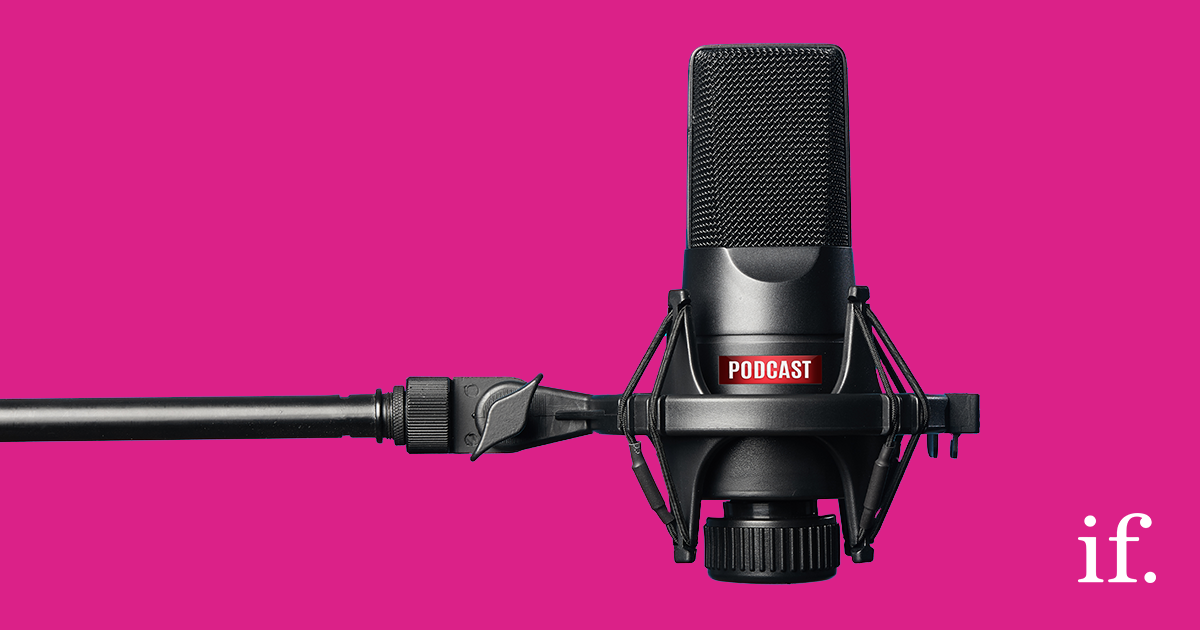Ep 32: Serious Social – Voice in social media with Anna Rust
In this episode of Serious Social, Laurens Grisel is joined by talented film actor/voice actor Anna Rust to discuss voice and how to apply it impactfully to your creatives on social media.
If you’re after more know-how to break the social boring, subscribe now.
Full Transcript
Welcome to the Serious Social podcast, created by the straight-talking social media experts at immediate future.
LG – In this episode of Serious Social, we talk about voice, and how to apply it to social media. Hello and welcome to the latest episode of Serious Social. My name is Laurens Grisel, I am an Account Manager at Immediate Future and I am joined here today by Anna Rust.AR – Hello.
LG – A actor of film, but also, lately, a little bit of voice acting.
AR – Yes.
LG – So, what have you been doing lately? Who are you?
AR – Who am I? What a question! I mean, not a lot. I have been taking a lot of baths. Shovelling cat poo.
LG – Yup. As we do.
AR – No, I mean, it has actually been surprisingly busier now, but I, I mean, film and TV is still really suffering under COVID. There is just virtually nothing currently filming because of insurance problems. But voice acting on the other hand has kind of picked up.
LG – It is a booming industry!
AR – At the moment. I mean, I was always doing like, you know, a video game here or there, or an audiobook, or something. But these days it has really picked up.
LG – Anything recent you have been working on you want to talk about?
AR – Yes? I do not know how much I can say. I, well, something that came out recently that I worked on relatively recently was Final Fantasy 14.
LG – Final Fantasy 14 is a video game, it is an MMO.
AR – Yep.
LG – Very widely played, good for you.
AR – Yep. It is a good game.
LG – Social media.
AR – Yes, that is why we are here.
LG – Voice in social. Why do you think social should see more audio being used? Or do you feel that way?
AR – Yeah, I do actually, and I do not say that from a biased, I am a voice actor please hire me. It is more of a thing of, like, audio can add a really nice, different layer to your creative.
LG – For sure.
AR – And it can, like, hammer down a point, or maybe even take what you are doing in a slightly different, less obvious direction when you are using voice acting? I mean, it has got a real potential to enhance your creative let’s just say.
LG – Well, what we do with it is emphasis.
AR – For the most part people do do that. Heh. Doodoo.
LG – Come on.
AR – This is Serious Social.
LG – You obviously have podcasts where people are talking, that is a separate thing, that is what we are doing. But with creatives, what we recently did was some stuff, actually you worked on this, where we had some tacos, and there was an eating happening, with like a taco being slowly edited away, and you added a crunching sound to it, and that added a really nice feel for it, because otherwise you are just editing a taco slowly going away.
AR – And things like, YUM. And, yeah. Noises.
LG – Eating noises?
AR – Yeah, eating noises, but mostly just enjoyment noises. Happy food noises.
LG – It depends so much on the platform as well where you use voice. I mean, I have some stats here. Facebook: 85% of people watch with sound off. Not the best platform for voice.
AR – Why are we doing this if that is the stats?
LG – No, but on Instagram 70% of people watching Instagram Stories watch with sound on.
AR – Oh, that is much better.
LG – And then you have YouTube, where 96% of people watch with the sound on, but that is a whole separate thing.
AR – Do you have a stat for Snapchat?
LG – Do I?
AR – Do you? I can see his notes.
LG – 2/3 of videos with sound on. I mean, so, voice is this thing where, depending on the platform, it can be something you kind of do not need, or it can be something where it is almost missing when you do not have it.
AR – Yep. It can feel really empty.
LG – So, it is an added tool – it is just another thing in your tool bag. When you were working with us, was there a different way you approached it from the normal way you do voice acting?
AR – Voice acting, as in, for other commercials, or for like video games and like characters and stuff?
LG – Let us say, yes!
AR – Okay, great. Well, I mean, depending on, well, every commercial brief is going to be different. So, yes, in that respect, yeah, I mean, everyone wants a different tone, everyone wants a different layer, texture to your voice, even pitch sometimes, but when it comes to like, characters and stories and things like that, not as much as you would think. Yes, it is a different thing, but at the end of the day, you know, when you are watching a film and TV show, you are kind of hoping you as an actor will be able to convey what is happening to the character well enough that the audience will believe what is happening to that character. That is the whole point, we get sucked in and we want to believe it. One of the things I learned when I was training voice acting, when you are doing commercials, you are not want to be like a frickin robot, where you are like, ‘Buy this product and everything is great’.
LG – (Mocking) Buy this product.
AR – There you go.
LG – That is the one? That is what not to do, right?
AR – Yeah.
LG – I am a voice actor.
AR – What you want to do is, you kind of almost want to sound like you are their best friend, and you are actually, genuinely excited about this, and you want to tell them.
LG – We are always going for that conversational tone on social media.
AR – For the most part, and then you also have like NHS stay home, but even then I would say you are going to want to have a tone, a personable, kind tone that you are going to want to listen to.
LG – And of course, it all depends on what you want. You also have ads where it is like, you remember those ads back in the day where it was like, ‘You wouldn’t steal a car!’
AR – Yes, I do remember.
LG – There you do not want a personable tone. There you want a police guy coming at you.
AR – Yeah.
LG – What is like your ideal brief? Do you have one?
AR – Someone who knows what they want. I know it sounds really mean, but like, you get so often when people go, ‘Oh, yeah, just roll with it, see what happens’. And then, like, fifteen minutes in, you realise they really do know what they want, but maybe they just needed to discover it, I do not know. I like someone who is good at giving notes, who is free [available] and willing try different things, but who also has a very good, clear idea of what they are going for, you know? Like, at least what the goal of this creative is.
LG – Good note, good note, give us an idea of a good note. Would you try it as if you are feeling the emotion more, or is it the more specific the note the better, the more general the note?
AR – Again it really depends on what you are going for here, but sometimes you want to touch a certain nerve with people, again I would have to give specifics and I do not really want to here, sometimes you want to convey a particular emotion, make people feel a certain way, like you want them to be spurred into action, and that can be really useful, because sometimes you want to be more informative, more laid back, sometimes you really want to get people to do something, and that is a good distinction, for example.
LG – And we are getting away a bit from the simplicity of crunching sounds and tacos, but do
AR – Oh, wow, are you belittling my job.
LG – No, I mean, we worked on it.
AR – How dare you!
LG – But do you approach it more as like a character perspective, like, ‘I am feeling my mother just died, maybe I should have a more negative tone with this?’
AR – Look, I do not know, I cannot speak for everyone, but when it comes to commercials, do not do that, that is weird. If you are going to do a character, but this is not what we are discussing, then yeah, it can be helpful to have a back story.
AR – But with, commercials, I just kind of want to know what you are trying to convey, and who I am talking to.
LG – Sure, know your audience. So, a brief has audience, purpose, direction and good notes.
AR – And, ideally, I would love to see it, if that is okay? Like, if you have even a mock-up, I would love to see it?
LG – Oh, like the creative itself?
AR – Yes, a visual of the creative, that can really influence how I tackle this. If it is like bouncy, pretty colours, there is going to be a very different tone to something dark and moody.
LG – Well, that is an interesting issue that causes, because a lot of what we do, especially with sound, we are using timings from the sound to create the creative. So, that makes it more difficult to give you an idea of what we are going for. We always do mock-ups of the feel – like branding, the colour pallet – and I think we can at least give you an idea of what we are going for, but it is not like we can give you a play by play of exactly how this is going to play out.
AR – Exactly, and I do not need that, I just want a little feel for it, like sometimes, you know, going back to other voice acting, you do a video game, they give you a cute little animation idea of what your final character is going to look like, and that can be really helpful.
LG – Just some direction.
AR – Just something. Anything you can give me helps.
LG – Actually, I have some stats from what you did for us
AR – It went really badly.
LG – No, it went really well! So, organically, on Facebook, 1,000 impressions – and this is the top performing posts – 1,000 impressions, 1.3% engagement rate.
AR – Okay. That sounds good.
LG – It sounds good. Anything above a 1% engagement we kind of take as a base line – especially organically, because we are not paying for anything – people are looking at this content and engaging with it, at least the people that we want, because it is such a wide pool. And then on Twitter, impressions, 343 – three hundred people looking at you, listening to you crunching away, engagement rate 2.33%, so even better, then. And then, we did run this a little bit on paid – 66,000 views, on listening to you crunching away.
AR – I mean, that is a good way to spend your night.
LG – Those poor 66,000 people.
AR – I know, I feel pretty bad, honestly.
LG – So, during these times, probably a lot of people are thinking of getting into this, or at least, maybe even on the client side, maybe thinking of what they would need in-house to do this themselves. Let’s talk technical perspective first – what do people really need to get started with adding voice to their creatives?
AR – Uh, your phone mic is fine, maybe even like record it through Skype. Do not do that.
LG – I was about to say, this is horrible advice.
AR – No, do not do that. Genuinely, at the end of the day, if you do not mind too much about like how professional it sounds, a good quality mic is all you really need. If you want to step it up a notch, I mean, actually, I say that, a good quality mic, a way to connect it to your recording device, you definitely need a recording software of some kind, a pop filter is crucial.
LG – We have a pop filter here. Can you, like, demonstrate the difference?
AR – I will, I will. So, basically, here is the difference. I am going to give you, let’s see, what is a p word.
LG – Pop.
AR – Yeah, sure, pop. Normally, I mean, you know, you do not want any air to come and be hitting the mic, because that sound is going to really like spill and it becomes very difficult to edit, I do not know the specifics, but it becomes very difficult to edit. So, it goes from pop, to POP. Can you hear that kind of air hitting it?
LG – That breathiness that is coming through with it.
AR – Yes, and that is what you kind of want to avoid, and a pop filter should do the trick, but try to lessen your plosives as well.
LG – And we have a nice little sound insulating room, here.
AR – We do! You do not really need this. If you are going to do a really basic thing, I think you can get away with it, but my goodness does it make a difference, and then you do not have to spend so much time in post, but you want a couple of acoustic panels if you can, and if not, just use some duvets, like, duvets are great sound insulating devices, go into a room, go into a cupboard or something, it will be plenty.
LG – what do you think about the idea of, so, someone has gone to the trouble of getting a mic, getting an amp, getting all of it, now they want to hire someone. Do they just run up to someone in their company and say, ‘hey, can you do some voice?’ Or do they hire someone?
AR – It depends. I mean, if you are going for that kind of real feel, we hire only real people, then yeah, you can—
LG – And just to interject, there is value in that.
AR – There is value in that, but please pick someone who can actually talk without being super awkward.
LG – There is always one in the company.
AR – Yes, so, seek that person out, because otherwise you end up with creatives that are just so cringe, and so difficult to watch because the people either clearly hate being in front of the camera, or in front of a microphone, and it really shows, and it makes your creative, like, unwatchable. If you can, hire someone, if that is the direction you are going in, and I think most people are, hire someone who does this for a living. It does not have to be me, but, you know, if you want me, my name is Anna Rust, and my agent is – no, can I not do that?
LG – Of course, you can! I mean, why are you here?
AR – No, but genuinely hire a professional who can really take that extra step to sell what you are trying to sell, or to convince people to do what you are to convince them to do, it really does make a difference.
LG – It is funny, like, we will watch an ad sometimes and there will be some voice over and we will just cringe.
AR – It is so painful, and you are like, what are you doing?
LG – Why did you not
AR – Why did you not just, you probably spent a fraction of the cost, but your ROI is going to be so much less—
LG – And that is what is really going on right. You want that engagement – positive engagement, more than negative – and you are not going to get it if it is just not good.
AR – Exactly.
LG – But it is a trade-off, though. Some companies do not have the capital in – I mean, how much do you cost?
AR – I am expensive.
LG – No you are not.
AR – I am basically free. Is there a middle ground?
LG – In general, voice acting does not cost that much. It depends on what you are working on, what kind of audience, obviously, like, the bigger the audience, if you are doing like a world-wide, you know, cinema, TV, film – no, wait, that does not make sense. Cinema, TV, print – also does not make sense for voice. Oh my gosh, I am tanking this. If you are doing a wide range of creatives
LG – Social media?
AR – Yes, that is right, social media!
LG – Cinema, TV and social media – rule of three!
AR – There you go! And the territories are world-wide, then you are going to have to pay a little more, but if you are doing like a little UK channel, and it is like, you know, for one post and that post is just going to be around for a bit, then it does not really matter, it is not going to be a lot.
LG – And you are talking about paying there. That is licensing that we are talking about, right?
AR – Yes.
LG – So, how does that work? Buyouts, all that good stuff.
AR – So, I do not know a huge amount about this, I tend to let my agent this.
LG – That is what agents are for.
AR – That is kind of what they are for. But, basically, a buyout means you are paying a creative like an actor or a voice actor or whatever, this generally only goes for commercials and voice work, not really for film and TV, but you are paying a person to gain full rights to the work you produce. So, then that means that for a year or whatever in UK and Ireland or whatever, you own that voice creative. It does not belong to the actor.
LG – Sure. And in terms of actually paying for the actor’s time. So, you have paid for a buyout, and then you also pay for the hourly rate, or whatever it is
AR – In voice, it would be an hourly rate, I have not heard of it ever not be, so it is almost always an hourly rate.
LG – Is the buyout a percentage of the hourly rate?
AR – No, it depends, it is complicated.
LG – Okay, so it just depends project to project.
AR – And it depends on the type of project it is as well.
LG – And the idea of a buyout is to, essentially, pay for them for the loss of work that they would be getting otherwise?
AR – Pay them for the work they are doing, for like, yeah, they give over the rights to you.
LG – Sure. Well, I think I have heard more than I was expecting to about voice.
AR – You have heard enough!
LG – I have heard plenty.
LG – Thank you for joining us for this episode of Serious Social.
AR – Thank you for joining us.
LG – Can you do like a nice, commercial voice for taking us out?
AR – There is no commercial voice, that is the point – it is meant to be personable.
LG – Alright, a personable voice.
AR – Thank you so much for joining us, we really, really enjoyed making this and we look forward to hearing you on the next one, is there a next one?
LG – Hearing us? We speak.
AR – What?
LG – Hearing you on the next one.
AR – Right! Hire me, I am great.
LG – I did not give her lines. Bye!
AR – Bye!
If you’re after more know-how to break the social boring, subscribe now and check out the show notes for links to our website and social profiles.




